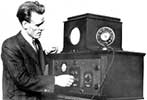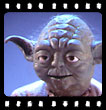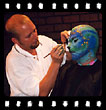|
Behind
the Screen: Making Motion Pictures and Television
|
||||||
by
Ellyn Hament
On loan from The American Museum of the Moving Image in New York and based on its permanent collection, Behind the Screen uses interactive experiences, actual tools and products of the trade, art, and audio-visual materials to take you behind the scenes of motion picture and television production. You can learn the basics – how projectors, television receivers, and film and television cameras work, what goes on inside a TV control room, how sound is recorded, and much more. You can also try your hand at using a variety of state-of-the-art tools and techniques throughout the exhibition. Behind the Screen spans several centuries in the history of moving images. It includes nineteenth-century moving image toys and a Mutoscope for viewing authentic moving-image short subjects, plus cameras and equipment from the early twentieth century. Fast forward to the twenty-first century and you can check out the newest technology in the exhibition's Demonstration Theater, including an advanced computer graphics platform. If, like me, you harbor a secret desire to dub your own voice into a major motion picture, then you'll enjoy the exhibit that enables you to do that with Babe, Glory, To Have and Have Not, My Fair Lady, or Taxi Driver, using the same steps actors take during postproduction dubbing. You might also want to visit the Special Effects section, where some of the mysteries behind making fantastic footage are revealed.
We also plan to complement this exhibition with an exciting series of special films and events, which will celebrate the film community in the Bay Area and explore the art, science, and process of film as a tool for both artists and scientists. It's an interesting side of the Exploratorium that you don't often see in such a strong spotlight. As Liz Keim, the Exploratorium's Director of Film Programs notes, "On the floor of the Exploratorium are many models of the way the world works. We don't have a tornado, we have a model of a tornado. Film provides models of the world, too, and enables us to see human relationships and science in ways that don’t normally fit into our museum."
From there, the programming will move in lots of interesting directions. It will cover early animation (before Mickey Mouse) and explore how artists in the twentieth century have worked with "found footage," existing footage that’s put in new contexts. We'll look at the origins of scientific cinematography, show highlights from Montreal's Téléscience Festival (one of the largest scientific documentary festivals in the world), and take a look at 1940s footage of Einstein trying out new special effects for film. Turning to cultural issues, we'll explore how African-Americans have been portrayed over time through the work of filmmaker Marlon Riggs, and trace the evolution of deeply rooted stereotypes through a film called Ethnic Notions. Examining movie-making itself, we'll take a close look at the work of Foley artists, who create nondialogue sounds–such as footsteps on stairs–and meet a real Foley artist, who will demonstrate this work live while films are being screened. Behind the Screen opened at the Exploratorium on February 10, 2001, and runs through September 3, 2001. Be sure to stop by, step behind the screen, and discover what it takes to make truly moving images.
Exhibition
made possible with support from
First Republic Bank
and
Lucasfilm
Ltd
.
|
||||||
|
|






 In
addition to workstations and studios, the exhibition also includes fascinating
artifacts. You'll not only learn how current television and film cameras
work, but you’ll also see one of Paramount's 35mm newsreel cameras,
circa 1927, and several artifacts used from 1933—1970 in the development
of the camera tube, including early image dissectors, as well as a vintage
Western Electric microphone from 1928. Star Wars fans will get to peek
at Chewbacca's costume head from the 1977 film, as well as a Yoda puppet
from The Empire Strikes Back.
In
addition to workstations and studios, the exhibition also includes fascinating
artifacts. You'll not only learn how current television and film cameras
work, but you’ll also see one of Paramount's 35mm newsreel cameras,
circa 1927, and several artifacts used from 1933—1970 in the development
of the camera tube, including early image dissectors, as well as a vintage
Western Electric microphone from 1928. Star Wars fans will get to peek
at Chewbacca's costume head from the 1977 film, as well as a Yoda puppet
from The Empire Strikes Back.
 Behind
the Screen's special programming kicks off with Chuck Workman's Oscar-winning
film Precious Images, a fast-paced series of clips from the last fifty
years of our favorite movies. It will be shown in conjunction with a
contest to identify the largest number of movies shown in the film.
(Later in the series, Workman will appear in person to discuss how cinematic
images are created and what makes certain images so powerful.)
Behind
the Screen's special programming kicks off with Chuck Workman's Oscar-winning
film Precious Images, a fast-paced series of clips from the last fifty
years of our favorite movies. It will be shown in conjunction with a
contest to identify the largest number of movies shown in the film.
(Later in the series, Workman will appear in person to discuss how cinematic
images are created and what makes certain images so powerful.)
